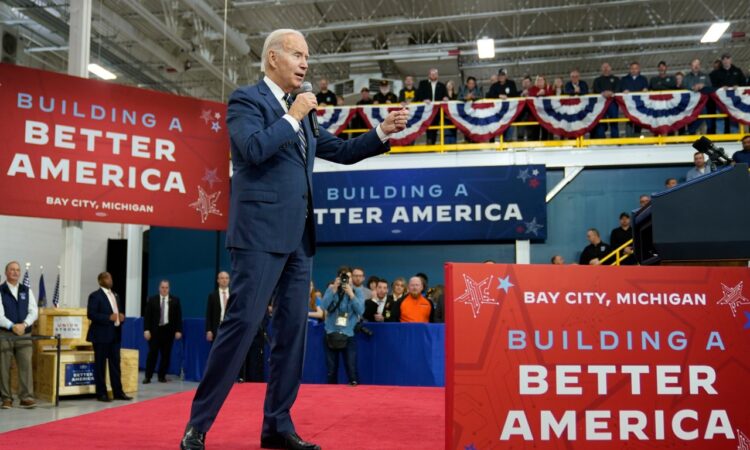
If President Biden delivers on his promise to bring a new era of jobs and prosperity to blue-collar America, it could be a game changer with working-class voters in the U.S. and beyond.
The Democrats may hold the presidency and, narrowly, the Senate, but their declining vote share among working-class voters and places means they face a much narrower path to victory. Combined with their falling support among Hispanic voters, and an electorate not confident that the country is on the right path, the Democrats face significant challenges ahead of the 2024 presidential election.
Looking across the Atlantic provides some painful lessons in what happens when center-left parties overlook their working-class base. Working-class voters began to pull away from the British Labour Party during the New Labour government years. But it wasn’t until the arrival of Boris Johnson’s brand of Conservatives in 2019 that Labour lost working-class voters and constituencies in historic numbers. That delivered the Conservatives an 80-seat majority in the House of Commons, and for Labour, its worst defeat since 1935.
Under the new leadership of Keir Starmer, whom I served as director of policy, Labour is undergoing a remarkable transformation in its electoral fortunes. The party has gone from 26 points behind when Starmer became leader in April 2020 to up to 26 points ahead, including an 18-point lead among working-class voters. A mid-term poll lead is not a general election victory, but with an election likely another year away, there is all to play for in the battleground that has become so central to U.K. and U.S. politics.
The multi-ethnic working-class vote matters, both in the U.S. and in the U.K., because there isn’t a path to electoral success for the center-left without it. There just isn’t an alternative coalition of voters that is large enough. If you can win the working-class vote, you can win the election, and win big. The traditional working-class may be a smaller proportion of our populations. But as I set out in my book, “The New Working Class,” before I joined Starmer’s team, our modern economies have created a new working class that is as sizable as its predecessor. More fragmented, more service-sector orientated, certainly more diverse in ethnicity, gender and geography, but a class of voters nonetheless that could hold the balance come election time.
Starmer gets this, as he has put working-class voters at the heart of his appeal to the electorate, and Biden certainly does. He wrapped it up in an American flag in his State of the Union address with a “blue-collar blueprint” to rebuild America. The Bipartisan Infrastructure Law, Inflation Reduction Act and the CHIPS and Science Act are all aimed at bringing a new era of jobs and prosperity to blue-collar America.
While Conservative chancellor of the Exchequer Jeremy Hunt recently rejected taking a Biden-style approach to fiscally responsible public investment as “some distortive global subsidy race,” Labour has actively embraced the shift to investing in future technologies, industries and new sources of energy and production. In case anyone was in any doubt, the party issued a press release that included in its headline: “Labour’s Green Prosperity Plan will be Labour’s version of President Biden’s Inflation Reduction Act.”
Britain is watching Biden’s blue-collar blueprint because the policy path is becoming an important dividing line between the status quo economists of the Conservatives and the revived center-left in Labour. But also because if it delivers, as it must, a new era of American jobs and prosperity for the people and places the president describes as forgotten, it could be part of the blueprint for winning over working-class voters as well as a blueprint for economic renewal.
If it is to stand any chance of turning around the decline with working-class voters, then the grand statements of high policy need to translate into economic improvements for ordinary Americans, and fast. New economic and energy infrastructure takes time to build and is abstract compared to the urgency people feel right now about the inflation affecting their finances.
The emphasis on blue-collar economics is a necessary shift for the center-left. But it needs to be matched with an orientation to blue-collar society and representation to move the dial with working-class voters. Voters care about better jobs, better wages, more opportunities and lower costs — of course they do. But they also want lower crime, managed immigration and access to better health care. Politics is about what you do, but it’s also about who you are and who you stand for.
Biden’s blue-collar blueprint has the potential to transform the American economy. Only time will tell whether it transforms the Democrats’ relationship with working-class voters. If it does, it will provide inspiration in the U.S. and beyond to a new generation of center-left political parties, once again rooted in the class they came from.
Claire Ainsley is director of the Center-Left Renewal project at the Progressive Policy Institute. She served as executive director of policy to UK Labour leader Keir Starmer from 2020-2022 and is the author of “The New Working Class: How to Win Hearts, Minds and Votes.”
Copyright 2023 Nexstar Media Inc. All rights reserved. This material may not be published, broadcast, rewritten, or redistributed.






